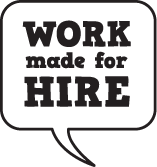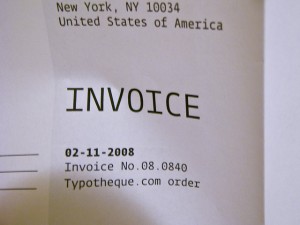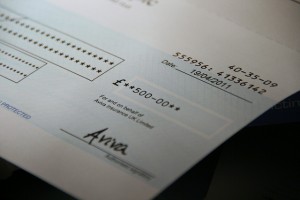Get paid!
Not all negotiation work happens in the midst of fleshing out the details of a job, with the sweat of contract terms glistening on your brow and the fire of fee arrangements in your belly.
Some of the most helpful negotiation work you can do is when you aren’t negotiating. And one of the best opportunities you have is when you bill your clients. You can use your invoices to make your clients happy and help you get bigger and better fees in the future.
Most people do not like paying bills. They like the services that led to the bill and they like not having to do the work
that someone else to did, but the bill? Not so much.
Invoices represent money that we no longer have to spend on other things. So you’d think that folks would spend extra effort to make sure their invoices highlight the great deal their client got, but very few people do.
Invoices should be easy to read, should tell people how much they owe, where to send the check to and how many days they have to pay the bill. That’s basic and there are a lot of good posts out there to help you figure out the basics.
But once you have your basics figured out, once that template is full of spaces to fill, you need to take it a step further and issue invoices that advertise what great services you provide, that make your clients feel like they’re getting a great deal and that will help justify better fees on future jobs.
So how do you do that?
Services
How do you currently describe services on the invoices you send out?
“Web design and implementation”?
“Four 8″ x 10″ illustrations of dogs”?
“Kick off meeting”?
All of those descriptions are boring. They are also not very helpful if you want to understand what you’re paying for.
I don’t know about you, but I do not enjoy paying bills for boring things that I don’t really quite understand.
Describe your services as if you had to pay the amount on the invoice.
Provide detail that highlights how this service or good was special to your clients. Describe supplies or goods to underscore their quality. Identify the different tasks you performed to provide the particular service.
“Customized redesign for workmadeforhire.net focused on making the site easier to read and update. Added an improved commenting interface, more efficient media organization and personalized illustrations.”
“Four 8″ x 10″ commissioned ink and watercolor illustrations based on Client’s pets.”
“Facilitated project kick off meeting with stakeholders, explaining the project’s timeline, gathering information about deliverables and establishing a communication protocol for issues. Included two hours preparation work and follow-up phone call with project sponsor.”
Discounts
Do you ever do work that you don’t bill your clients for? An hour that you don’t feel comfortable billing out at full price or you used a template that you had stashed in your back pocket? Do you tell your clients about that work and that you aren’t charging them for it? My guess is “No.”
There is no way your clients can know what you are doing for them if you don’t tell them. It might not seem like a huge deal to you that you dropped off the finished prints at their office because you were in the neighborhood, but it is work that you did for them and it should show up on your invoice.
This is also a great way of feeling better for stuff you can’t really bill for but that annoyed the crap out of you at the time. If you called up to see if your revisions were OK and were then subjected to your client’s tales of this year’s family reunion shenanigans and lost 20 precious minutes of you life, you should at least use it on your invoice to show your client how awesome you are. (“Complimentary follow up phone call to ensure revisions met expectations,” by the way.)
Many freelancers complain that clients don’t understand all of the work that they do for them. And they’re right; many clients don’t understand. So tell them. Make them better educated clients and better able to value what you do for them.
Payment
Not being paid sucks and sadly it is something many freelancers struggle with. Some clients will be slow to pay their bills, some will haggle over the details and others will just plain not pay.
It is easier to entice good behavior than it is to punish people for their bad behavior.
Make your invoices stand out and get paid by making it worthwhile to your client. Offer a 2%/10 discount where the client gets a discount of 2% if they pay within 10 days. (Make sure you factor that 2% discount into your fees when bidding the job.) I worked at a fairly good sized company where details like a 2%/10 discount really did impact the speed with which they are paid.
You can also entice good behavior by following what the contract says regarding invoices. Send it to the correct address listed in the contract and include all of the details the contract says you’ll include. Then follow up with an email and copy of the invoice to the person you had the most one-on-one interaction with. “Just wanted to let you know this went out today. Thanks!”
Use your invoices to show your clients how much you do for them and how great your services are. They’ll appreciate the detail you provide and remember it the next time they call about a job.
Featured Image by Ben Harding. via Flicker.com.
Categories: Negotiation Strategy








Great advice to let your customer know that you worked for them but will not be charging: “Complimentary follow up phone call to ensure revisions met expectations”…
As far as tracking the time you worked for a client, at your discretion, I would like to suggest my site http://www.CalculateHours.com, where you will find simple calculators that add up hours and minutes, as well a full selection of excel templates that calculate time-sheets.
You can find an easy Time Card Calculator at http://www.calculatehours.com/Time-Card-Calculator.html
I hope you find it to be of value to your readers.